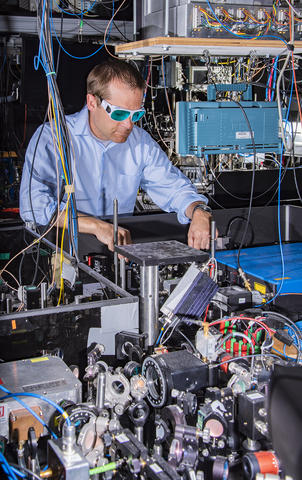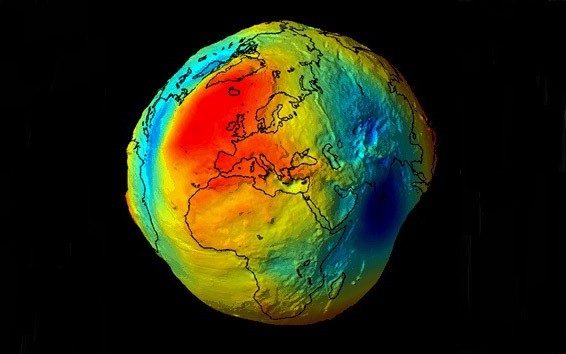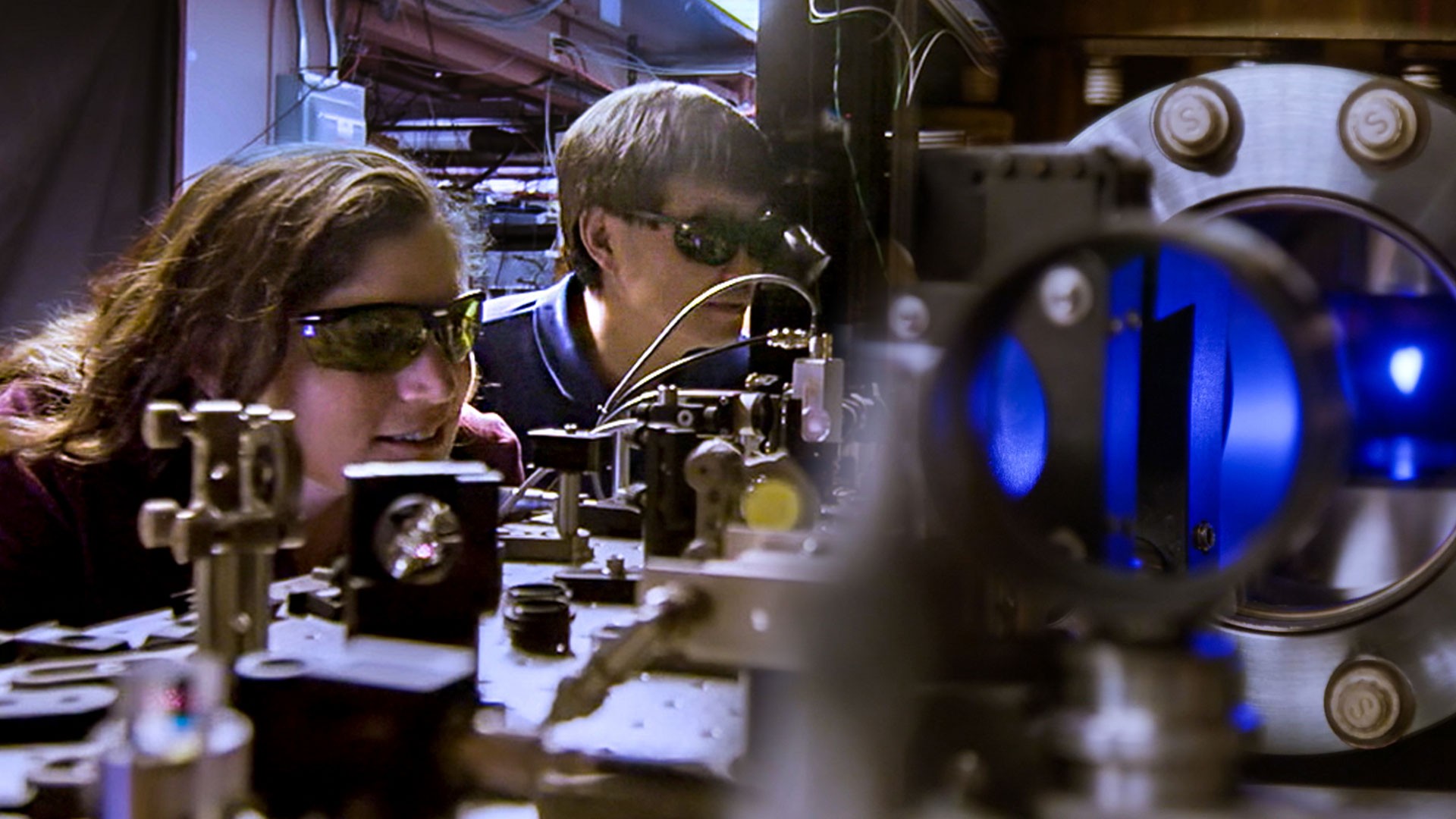The NIST optical atomic clock that is the most accurate time keeping device ever made. Image: NIST
Researchers at the National Institute for Standards and Technology (NIST) have developed an atomic clock that is so precise that our models of Earth’s gravity aren’t accurate enough to keep up with it. As detailed in a paper published this week in Nature , the atomic clock could pave the way for creating an unprecedented map of the way the Earth’s gravity distorts spacetime and even shed light on the development of the early universe.“The level of clock performance being reported is such that we don’t actually know how to account for it well enough to support the level of performance the clock achieves, ” Andrew Ludlow, a physicist at NIST and the project lead on the organization’s new atomic clock, told me on the phone. “Right now the state of the art techniques aren’t quite good enough so we’re limited by how well we understand gravity on different parts of the Earth.”Before diving into the nitty gritty of what Ludlow and his colleagues at NIST have accomplished, however, it will help to have some background on the nature of time and atomic clocks.Regardless of what your college roommate said while you were hitting the bong, as far as most scientists are concerned time is a measurement of periodic occurrences. In other words, time is the thing that measures it, otherwise known as a clock. Pretty much anything that occurs at regular frequencies can be regarded as a clock, such as the swing of a pendulum, the rotation of the Earth around its axis, or the philosopher Emanuel Kant taking his morning stroll around the neighborhood.Obviously, not all clocks are created equal. Each clock varies in terms of its accuracy (how much its oscillation frequency deviates from some baseline) and its time scale. If you needed to measure the passage of five minutes, using the Earth’s rotation as a clock isn’t going to be particularly useful. Likewise, if you never wound your watch, it would gradually become less accurate over time due to small imperfections in the mechanics.Most of us deal with timescales ranging from years to seconds, which don’t require incredibly accurate clocks. Yet for scientists working on the bleeding edge of physics, they require much more precise measurements of the passage of time. Fortunately, nature came endowed with incredibly precise clocks of her own in the form of atomic energy transitions.Electrons orbit the nucleus of an atom at certain stable energy levels that depend on the electrical properties of the nucleus. These orbits can be changed by adding energy to the system, which causes the electrons to temporarily get bumped up to a higher energy level and emit electromagnetic radiation during the transition. Different types of atoms are able to absorb energy at different wavelengths and this feature is harnessed to create the most precise clocks in the world.Today, four atomic clocks can be found on each of the 24 GPS satellites orbiting Earth and are used to synchronize time in our cell phones and billions of other internet connected devices. They’re also used to measure the mean sea level, which is used to understand the way our planet’s gravity warps spacetime. Knowing this information is important for calibrating the space-based atomic clocks themselves, but despite the accuracy of these clocks—NIST has an atomic clock that only deviates by one second every 200 million years—there’s always room for improvement.In this respect, NIST’s new atomic clock over-delivered. It’s so precise that our current models of Earth’s gravity can’t keep up with it. Fortunately, the new clock will help change that. This is the most banal of questions, but also one of the most difficult for physicists to answer. The reason for this, as Einstein discovered, is that time is not absolute. Rather, the passage of time is relative. It depends on the observer’s frame of reference, which is affected by things like their velocity and the strength of gravity within their reference frame. For example, a person near a strong gravitational field, such as a black hole, would experience time moving more slowly than a person standing on the surface of the Earth.Humans experience time on a macroscale—days, hours, minutes—and in our day to day lives, we never move fast enough or travel into a strong enough gravitational field to notice a change in how fast or slow time is moving at these scales. Nevertheless, when I climb the stairs each evening to my apartment, time is speeding up whether I notice it or not.“It’s a small effect,” Ludlow said. “It’s kind of creepy that it’s real, but it is.”
This is the most banal of questions, but also one of the most difficult for physicists to answer. The reason for this, as Einstein discovered, is that time is not absolute. Rather, the passage of time is relative. It depends on the observer’s frame of reference, which is affected by things like their velocity and the strength of gravity within their reference frame. For example, a person near a strong gravitational field, such as a black hole, would experience time moving more slowly than a person standing on the surface of the Earth.Humans experience time on a macroscale—days, hours, minutes—and in our day to day lives, we never move fast enough or travel into a strong enough gravitational field to notice a change in how fast or slow time is moving at these scales. Nevertheless, when I climb the stairs each evening to my apartment, time is speeding up whether I notice it or not.“It’s a small effect,” Ludlow said. “It’s kind of creepy that it’s real, but it is.” The geoid is great for measuring the elevations of Earth’s surface to a high degree of accuracy, but it poses problems when it comes to creating ultra precise clocks. The reason for this is because the Earth is not, in fact, a geoid and differences in elevation induce meaningful gravitational effects on the measurement of time. This is most pronounced in instances where atomic clocks are separated by large distances, such as those on GPS satellites.Although scientists are able to account for these differences in Earth’s gravity at the surface, also known as geopotential heights, using the atomic clocks on satellites, they are only able to do so to a deviation of about 0.0000000000000001 seconds, equal to a change in elevation of about 0.9 meters. The new atomic clock developed by NIST, however, is so accurate that it is able to reduce this elevation change to only a centimeter, which is equivalent to an error of just 1.4 parts in a quintillion (a one followed by 18 zeros).According to Ludlow, this breakthrough was only possible due to the revolutionary nature of the clock itself. The atomic clocks used by NIST for this research consist of ytterbium atoms suspended in an array of laser beams. Although the potential latent in this technology has been known to physicists for years, it’s only in recent years that they’ve harnessed the technology to tap into these optical atomic clocks. Indeed, Ludlow said his team’s recent breakthrough is the culmination of years spent researching how to limit interference from things like nearby electric and magnetic fields.
The geoid is great for measuring the elevations of Earth’s surface to a high degree of accuracy, but it poses problems when it comes to creating ultra precise clocks. The reason for this is because the Earth is not, in fact, a geoid and differences in elevation induce meaningful gravitational effects on the measurement of time. This is most pronounced in instances where atomic clocks are separated by large distances, such as those on GPS satellites.Although scientists are able to account for these differences in Earth’s gravity at the surface, also known as geopotential heights, using the atomic clocks on satellites, they are only able to do so to a deviation of about 0.0000000000000001 seconds, equal to a change in elevation of about 0.9 meters. The new atomic clock developed by NIST, however, is so accurate that it is able to reduce this elevation change to only a centimeter, which is equivalent to an error of just 1.4 parts in a quintillion (a one followed by 18 zeros).According to Ludlow, this breakthrough was only possible due to the revolutionary nature of the clock itself. The atomic clocks used by NIST for this research consist of ytterbium atoms suspended in an array of laser beams. Although the potential latent in this technology has been known to physicists for years, it’s only in recent years that they’ve harnessed the technology to tap into these optical atomic clocks. Indeed, Ludlow said his team’s recent breakthrough is the culmination of years spent researching how to limit interference from things like nearby electric and magnetic fields. Ludlow told me that the NIST atomic clock is both a scientific wall and a door. It is a wall in the sense that it is so precise that the current measurements of the geoid actually restrain the accuracy of the atomic clock since it provides geopotential resolution on the order of many centimeters whereas their clock can reduce this geopotential resolution to just a centimeter. On the other hand, NIST’s atomic clock is a door in the sense that it can be used to improve geodetic resolution several times over. This would involve distributing several of these clocks around the world and measuring the slight deviations in their time keeping to get the highest ever resolution map of how the Earth’s gravity warps spacetime.“If you had clocks that you trusted that were both accurate at this very high level then you could use those clocks as sensors of the Earth’s gravity potential by looking for changes in the ticking rate as you moved one of the clocks through different parts of Earth’s gravity,” Ludlow told me.Ludlow said he and his NIST colleagues are currently working on prototypes for portable versions of their atomic clock that they can use to test this idea. It will probably be several years before they are distributed on Earth or in space, but in the meantime NIST’s clock may be put to other uses, such as redefining the second to even greater accuracy.
Ludlow told me that the NIST atomic clock is both a scientific wall and a door. It is a wall in the sense that it is so precise that the current measurements of the geoid actually restrain the accuracy of the atomic clock since it provides geopotential resolution on the order of many centimeters whereas their clock can reduce this geopotential resolution to just a centimeter. On the other hand, NIST’s atomic clock is a door in the sense that it can be used to improve geodetic resolution several times over. This would involve distributing several of these clocks around the world and measuring the slight deviations in their time keeping to get the highest ever resolution map of how the Earth’s gravity warps spacetime.“If you had clocks that you trusted that were both accurate at this very high level then you could use those clocks as sensors of the Earth’s gravity potential by looking for changes in the ticking rate as you moved one of the clocks through different parts of Earth’s gravity,” Ludlow told me.Ludlow said he and his NIST colleagues are currently working on prototypes for portable versions of their atomic clock that they can use to test this idea. It will probably be several years before they are distributed on Earth or in space, but in the meantime NIST’s clock may be put to other uses, such as redefining the second to even greater accuracy.
Advertisement
WHAT IS TIME AND HOW DO ATOMIC CLOCKS MEASURE IT?
Advertisement
The first atomic clock was created in 1955 and used the energy transition of an electron in a cesium-133 atom as its frequency referent. Cesium-133 atoms absorb energy at wavelengths of 3.2 cm, which means the wave oscillates at a frequency of 9,192,631,770 cycles per second. When cesium-133 atoms are hit with microwaves at this frequency, it causes the atom’s single outermost electron to rapidly transition between energy states at the same rate. In this case, the electron transitioning between a high and low energy state over 9 billion times a second is analogous to a rapidly swinging pendulum in a conventional clock. In fact, the transition of the cesium-133 electron was used to formally define the length of a second in 1967.Read More: Why Nuclear Clocks Will Be the Most Accurate Clocks on Earth
Advertisement

WHAT TIME IS IT?
Advertisement
With each step I climb, I am moving farther away from Earth’s center of gravity, which means that gravity’s effect on the frequency of whatever oscillating thing I am using as a clock diminishes. Physicists have calculated just how much gravity affects time based on how high a clock is above the Earth’s surface and found that it is 1.1 quintillionth of a second for every vertical centimeter that clock is lifted above the surface. In other words, one second measured on the surface of the Earth actually takes 0.000000000000000011 seconds less for a clock one centimeter above the Earth and so on.Of course, “the surface of the Earth” is shorthand since this can mean wildly different things depending on where you’re standing. Death Valley and the peak of Mount Everest are both technically the surface of the Earth, but one is 282 feet below sea level and the other is 29,000 feet above sea level. For that matter, the “sea level” itself is also in constant flux due to tidal changes.To address this problem, scientists conceive of the Earth as a “geoid.” This is the hypothetical shape of the Earth if the oceans were only subject to the force of Earth’s rotation and gravity, and were extended over all the continents. This is, in effect, equivalent to taking the mean of sea level across the entire Earth, which is done through a combination of ocean-based sensors and satellite data. When the geoid is visualized, it looks like this:Read More: An Energy War in the Balkans Slowed Europe’s Clocks By Five Minutes
Advertisement


